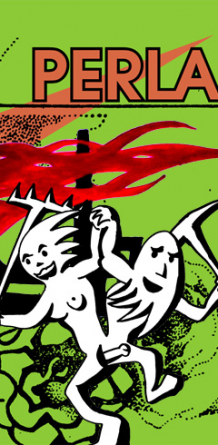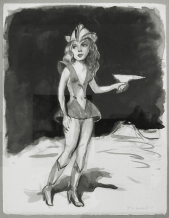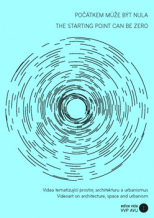| Umělec 2002/3 >> Octobriana a ruský underground, part 3. | Просмотр всех номеров | ||||||||||||
|
|||||||||||||
Octobriana a ruský underground, part 3.Umělec 2002/301.03.2002 Tomáš Pospiszyl | focus | en cs |
|||||||||||||
|
"Dangerous Naivete
The book itself is almost innocent by today’s standards. It documented a counter-culture behind the Iron Curtain — something everyone interested in this part of the world already knew existed. Nevertheless, the format lured an audience that lacked solid information on the socialist camp. With the popularity of the left-wing rising among young people in the late 1960s and early 1970s, the book served as a sort of warning. Octobriana was not the first comic involved in the Cold War, however. Simplified politics, or rather ideology, was part of comic culture from its very beginnings, especially in the United States. In the 1940s, American comic superheroes battled Hitler and the Nazis; after World War II, communism became the hostile ideology. But references to the Cold War diminished in the 1960s amid the war in Vietnam and growing youth sympathy for left-wing ideology. At the same time, high and low culture began to converge. Comics became a serious art form, thanks only in part to Warhol and Lichtenstein’s use of comics in their work. The genre penetrated university auditoriums, became fashionable and attracted more and more adult readers. Spiderman and the Incredible Hulk joined Bob Dylan and Che Guevara as revolutionary icons of the 1960s. Under these circumstances, traditional, naive stories about superheroes had no punch. Comics had to take on serious political issues and ask unpleasant questions, analyzing the ideological stereotypes it had created. In a strange way, Octobriana was politically ambidextrous. She fought the Kremlin while maintaining her faith in the original ideals of the Revolution. If she were a clearcut anti-communist figure, Wesern youth probably would have rejected her. Her ambiguity and communist background made her interesting. Let us not forget that Sadecký himself was an enthusiastic communist sympathizer in his youth, an admirer of the Soviet avantgarde and, last but not least, an agent of the Czechoslovak secret police. Although he wanted to draw attention to political oppression throughout the Soviet Union and the Eastern Bloc, he remained strangely abstract. Unlike American comics dealing with political issues, Octobriana lacked expression of the authors’ relationship to the immediate political situation. Rather, it merely portrayed the peculiar timelessness typical of pre-war adventure literature about exotic colonies. Sadecký does become specific in his detailed description of the PPP, its liaison officers and internal security regulations. He described how, purportedly, members photographed novices entering the secret organization — a practice strongly reminiscent of the secret police and its recruitment methods. The fictitious dissidents and artists were members of the communist Komsomol youth organization, and none of their friends or relatives even had a clue they were taking part in underground activities. The PPP was a fantasy world where they could forget about the reality around them. The reader gets the feeling that PPP members were based on real people, that they are token farewells to Sadecký’s friends in Prague. Octobriana is an amalgam of fabrications and reality nearly impossible to untangle. At the least, it reflects the author’s perception of Czechoslovakia in the 1960s. The description of his emotions during his military service, which he spent dreaming of future trips and adventures, is authentic. Octobriana gave Sadecký not only the opportunity to employ his gift for duplicity, but also to come to terms with his fate, sum up his life and prove to himself that he made the right choices. There was no hesitation when it came to sacrificing his best friends. Regardless, turning back was not an option. The Legend What kind of character is Octobriana anyway? She is a blond vixen, a superwoman from the Eastern Bloc who dominates men with her strength and intellect. She is also an advocate of “real” communism, which knows no limitations, promotes absolute freedom and free love and fights totalitarianism. Last but not least, Octobriana is characterized by the myth of her origin, the fragments of underground comics saved from the depths of Russia, which proved to be an utterly original idea. Although Octobriana wears a costume typical of Western comic heroes, she lacks their super qualities. She cannot fly or become invisible, nor does she have a sole arch-enemy. Wonder Woman aside, females in comics are usually victims; Octobriana is the driving force of her stories. The significant contribution of a female author to Octobriana’s birth is also unusual. The character serves to please primarily male readers, however. Octobriana’s nearly spastic eroticism responded to, among other things, the absence of sex or open nudity in official Soviet art — something the West couldn’t understand. Soviet culture knew woman as mother or fighter but not as sensuous lover or as an erotic being. For the Western reader, the Soviet Union had great sex appeal as a mysterious country, evident in the Bond girls, loved and liquidated. Only a few years before Octobriana, a sensational book called Moscow Diaries was published in the West. A cheap, pornographic work describing the purportedly wild sex life in socialist Moscow, which also proved to be a hoax. Part of Octobriana’s genealogy may be found in Czechoslovak adventure literature. Fantastic stories and mysteries not unlike those Sadecký fabricated appeared in articles and books by Ludvík Souček since the end of the 1960s; Velké Otazníky (Big Question Marks, 1967) and Tušení Stínu (Shadow Glimmer, 1975) were just two. His stories were full of adventures and utterly unlikely mystification. The author’s fabrications were masked by information coming from the Soviet Union, especially from Central Asian republics, that was entirely impossible to verify. Souček himself traveled to Mongolia and wrote the book Krotitelé Ďáblů (Devil Busters) about it. The illustrator of Big Question Marks was none other than Zdeněk Burian. It seems that both Souček and Sadecký sought to find out how much fiction their readers would bear. In his experiments, Sadecký tended to Dadaism; one picture in Octobriana features photographs of a space module with a group of prairie Indians wearing festive costumes. The original comic material and its execution in Octobriana approach unintentional self-parody. The play of genres evokes the Czechoslovak films Kdo Chce Zabít Jessii (Who Wants to Kill Jessie) or Čtyři Vraždy Stačí Drahoušku (Four Murders Are Enough, Honey), which were inspired by the world of comics and employed the star of Czech comics of that time, Kája Saudek. At the end of the 1960s and the beginning of the 1970s, Czechoslovak cinema produced a number of similar films, which employed elements of comics, sci-fi and espionage thrillers — genres that didn’t exist in Czechoslovak in their pure forms, but whose conventions filmmakers knew and used. Octobriana borrows a range of elements taken from or inspired by similar characters in Western culture. She bears closest resemblance to Jean-Claude Forest’s Barbarella, who first appeared in 1962. (Jane Fonda starred as the heroine in Roger Vadim’s 1968 film.) Sadecký himself noted the similarity. Fictitious PPP would not have known that Barbarella even existed. Where as Barbarella won thanks to the power of her orgasms, Octobriana relied on her muscles and wit. Although far from the feminist ideal, at the beginning of the 1970s she represented an unusually independent and strong female character, and she won a great number of fans among women. Octobriana and the Stars Within three years of the first Octobriana edition, film ideas began to surface. Octobriana was already a legend. The authorship scandal had quieted down and readers took her at face value — a crazy, sexy comic from the exotic Soviet Union. Octobriana found a new generation of admirers distanced from the ideal-ridden 1960s. The character attracted them with her combination of fantastic elements, fragmentation and effective superficiality. In 1974, pop star David Bowie decided to film Octobriana. There is no indication that Sadecký even knew of Bowie’s plan, much less approved of it. While Bowie is best known as a glam-rock idol his influence extended beyond music. His major work was his own alter ego, Ziggy Stardust, a half-alien, half-human, androgynous rock star. Coincidentally, Octobriana was published the same week Bowie recorded “The Rise and Fall of Ziggy Stardust and the Spiders From Mars.” It appears that Octobriana was part of the cultural background that gave rise to Ziggy Stardust. In fact, Octobriana and Ziggy Stardust are quite similar. Ziggy is an amalgam of opposing and antagonistic influences such as Lou Reed, Andy Warhol, Japanese culture, Metropolis, A Clockwork Orange, T. S. Eliot and much more. Octobriana combined Solzhenitsyn, Barbarella, Zdeněk Burian, and James Bond. Both Ziggy and Octobriana showed a remarkable ability to absorb various influences. What connects their personalities is pop culture and mass media. Flying saucers, bisexuals, communists fighting communism — all this seems likely, logical and even beautiful in the media world. Bowie, however, consciously worked with this mix of influences and components. To a certain extent Octobriana’s rich genealogy was accidental and improvisational, and it soon became impossible to develop her legend further for many reasons. References to Octobriana as a film project appeared twice in Bowie’s Mirabelle Diaries, his regular column in a magazine of the same name. Bowie’s authorship of these columns is questioned, but the idea of such a film would not be far off the mark. His androgynous figure was closer to the world of comics than reality. Bowie’s choice of the actress for the lead role came as no surprise either: Amanda Lear, who later became a disco diva of the 1970s, an erotically charged collage of various ambiguous elements. Artist of the Future Will Go Underground David Bowie was not the only pop star who was attracted to Octobriana. Punk artist Billy Idol had her tattooed on his arm, making them a couple difficult to separate. He often referred to Octobriana as a kind of higher entity in his rather heavy writing. The end of the 1960s saw a revolution in comics. The formerly simple genre dominated by conservative publishing corporations suddenly appealed to a new generation of artists for whom comics were a means to express their artistic and political views. Large comic book publishers naturally didn’t have much sympathy for such experiments. They were interested in profit. Maintaining their good relations with the government made it impossible to portray most controversial phenomena in the society of that time. These conditions helped give birth to underground comics as an alternative to the constrained corporate product. Underground comics dealt with feminism, ecology, drugs, racism and other topics traditional comics had either ignored or merely touched upon until then. San Francisco became the center of this new school. At the beginning of the 1970s, Octobriana arrived. There were no specialized stores at the time. Comic books were sold either in regular bookstores or in head shops. The San Francisco community prepared a warm welcome for Octobriana. Old timers recall that the main reason to purchase the book was the provocative cover. The other teaser included the magical word “underground” in its title. Left-leaning society was naturally interested in what was happening in the inaccessible Soviet Union and perceived Octobriana as an embodiment of its own ideal of a just communism with adventurous and anarchist elements. At that time, Octobriana represented the unusual feminist ideal of a women who was an erotic figure and at the same time able to take her fate in her own hands. Young underground comic artists were also attracted by the legend of her creation and were willing to overlook her pin-up roots. In the world of comics, Octobriana was a proud heroine of the Russian underground, a colleague from behind the Iron Curtain and not just oldfashioned rubbish — not to mention the hoax of the century. Reviews of Octobriana and the Russian Underground continued to appear in the comic press until 1974, almost three years after the book was first released. A Character for Use Most comic characters such as Superman or Spiderman are very carefully copyrighted by their publishing companies. The individual writers and artists may change, but the rights remain with the company, which can sell them to another publisher just like hockey teams buy and sell players. Only the owner of the copyright may use the character. There are legal precedents: American draftsman Raymond Pettibon had to give up Vavoom, taken over from an existing comics series, although the character had appeared in his drawings and installations for many years. Octobriana never had an official author in the traditional sense because Sadecký and the publisher insisted on the original version of the book’s creation. Although this is not official (and may be legally invalid), Octobriana has become public domain used by various comic artists in their own works. Some of them have continued within Sadecký’s intentions while others have taken Octobriana into new dimensions and tones. The renaissance of Octobriana began in the 1980s. She appeared as one of the main characters in Bryan Talbot’s legendary dark comic The Adventures of Luther Arkwright, running from 1979 until 1991. In 1988, one of her stories was reprinted in Finland. A series by Reimo Mäkinen and Timo Niemi from 1992 confirmed Octobriana’s position in Finnish comic culture. Comic collectors started to discuss the character again, gradually unveiling her unclear history. Most second-generation readers considered Sadecký’s story true. In Finland, the situation was a bit different, owing to that country’s proximity to the Soviet Union and a history of political ties with the country. Octobriana was just as unlikely to the Fins as she was to Eastern Europeans. In the 1990s, Mäkinen directed the comic community’s attention to two Stern articles and other serious cracks in Sadecký’s legend. Like the Finnish rock band the Leningrad Cowboys, Octobriana is an ironic postmodern remark to history, a way to cope with totalitarianism and bolshevism, a sentimental recollection of the old times. However, the many artists working with Octobriana in the 1990s did not perceive such subtleties. Larry Welz’s pornographic 1992 story Cherry Jubilee revolved around the sexual adventures of the sophisticated yet naive schoolgirl Cherry. Octobriana appeared in one series dressed in leather clothes like a dominatrix. Artful Salamander published Stuart Taylor and Dave Roberts’ Octobriana series from 1996 to 1998 and printed more than a dozen sequels. Since 1996, British publisher Revolution Comics has printed an Octobriana series by John A. Short and a number of artists; the most recent installment was “The Commie Zombie Dictator from Hell” in 2001. Octobriana’s appearances in other comics, posters and advertisements are too numerous to list here. The beginning of the third millennium saw several Octobriana web pages as well as a number of comic projects in preparation. Rumor has it that Italian filmmakers made an Octobriana feature some years ago, but more likely the first Octobriana film was Finnish director Jyrki Pitkä’s picture Octobriana and Lenin’s Finger, which opened in Finland in August 2002. Octobriana has not been entirely forgotten in the Czech Republic either. The team behind comic magazine Aargh is preparing an article on the character to be published at the end of 2002, complemented by a new short story by artist Karel Jerie. Adventures of the Great Mystifier What did Sadecký know of the renewed interest in his character in the 1980s and 1990s? Unfortunately, there is not much information about his later life. He lived mostly in Göttingen, Germany, and discontinued his work in comics. The Institute for Research on the USSR in Munich ceased to exist; other information agencies failed to take him on due to his tendency to create an air of mystification and his inability to evaluate situations with sobriety. Reportedly, he worked as a freelance journalist cooperating with various German TV stations. He also attempted several complicated insurance scams but there is no record of the results. Sadecký’s admiration of Burian continued, although he must have realized that he had lost their friendship for good. He wrote several features on Burian for German magazines and, in 1982, he published an extensive Burian biography in Bonn. The monumental work contained numerous fabrications, including dozens of books Burian allegedly illustrated. Sadecký also worked as unofficial dealer of Burian’s paintings and drawings. Without Burian’s knowledge, Sadecký made several paintings based on his Mongolský Náčelník (Mongolian Chief, 1979), commissioned by Ericson and Ursula Aufderhaar. Immediately following Burian’s death in the late 1980s, Sadecký tried to smuggle an article on Burian’s statues into the Czechoslovak magazine Živa. He also promoted the theory that Burian drew some of his prehistoric reconstructions after the mysterious monographist WMW. Sadecký had a girlfriend and a daughter in Germany, but no one researching his story has been able to contact them. Throughout the 1970s and 1980s, Sadecký corresponded with a number of people in Czechoslovakia. Although it is impossible to reconstruct his life from these letters, it becomes apparent that in the early 1990s his health began to fail. He had trouble differentiating between fantasy and reality and his handwriting changed dramatically. Sometimes he was not able to write more than a few gigantic letters on a page. Petr Sadecký died from an extensive brain tumor in 1991. With so much unknown about Sadecký’s life, it is difficult to judge him. That he committed forgery and consciously appropriated other artists’ work is certain, but his motives remain unclear. Surely he knew his action would cost him his best friends and colleagues. His ambition often hurt those close to him. He wanted to stand out and had a boyish longing for adventure. Also, the tumor that eventually killed him may have affected his mental capacity years before his death. Character Transformation Today, comics are a standard art medium. Comics commenting on the Holocaust or human isolation no longer surprise us. Formerly the bottom of the entertainment barrel, comics have become a remarkably precise tool for commenting on politics and society, especially in the United States. Europeans have, for the most part, found the genre primitive and infantile, thereby missing out on a novel new media and the often marvelously progressive ideologies expressed in it. More than 30 years ago, Sadecký attempted to portray life in a totalitarian society. Octobriana’s birth and adventures were conditional on the Cold War and the global politics of the time. Her story demonstrated the isolation of the two hostile camps and a general curiosity about what was happening on the other side. While not impenetrable, the Iron Curtain deformed in a peculiar way information passing through it. Many Western readers did not doubt Octobriana’s authenticity, but even if they had, they had no way to check it. They had only the comic and the vague feeling that some of it was fishy. Communist propaganda deformed any information about Octobriana that made it to the East. Very few people had actually seen the comic. Impossible as the legend may have been, it was not much easier to learn the truth. Although Octobriana has demonstrated a remarkable viability, it was from the start a failed and lost project that readers never saw in its initial form. Only the illustrators were familiar with the original Amazona concept and only fragments of Sadecký’s bastardized version were released. Few survive who have seen the complete adventures of Octobriana with their own eyes. After winning the lawsuit in Bamberg, Konečný took the altered Amazona back to Czechoslovakia, where it disappeared. Considering that he had worked on the project for many years, Konečný must have had a large number of drawings, unpublishable, which he either hid or destroyed. There were no traces of Octobriana in Konečný’s estate. Maybe the work will emerge somewhere a few years from now, or maybe it will remain a legend, existing only in the imagination. Perhaps that is the best ending for it. Most works of art are perceived primarily on the level of the story they convey. However, the story of the artistic text permeates this particular fiction. We can only guess at the author’s relationship to his work. A reflection of reality surrounded the author, even in the most fantastic stories. A good book makes the reader want to discover the truth about the work and the author, to understand the work and the context that created it. Eastern European readers of Sadecký’s time were accustomed to looking for concealed messages in the stories they read. A simple sentence in the official lingo often had a contradictory meaning in reality. Sadecký’s circumstances made it difficult for him to express himself directly, but his duplicitous nature aided him in encoding his message. Once free of censors and ideological obstacles, he employed the same principles in aid of different principles. And comics are incredibly malleable. By simply changing the text in a bubble, the artist completely changes the story’s meaning. The Situationiste Internationale in France used a similar strategy in their work, replacing the text of classic American comic stories with their own Marxist revolutionary appeals. Perhaps more so than heroes of high literature, comic characters personify their authors’ desires and readers’ expectations. Superman can fly; he is absolutely free. His fans came from poor immigrant backgrounds; they lived in a land of unlimited possibilities, which only a few could reach. Similarly, Amazona expressed a desire for adventure, to explore exotic countries, to experience the Wild West as seen in films. She became Octobriana when this dream of a free world vanished. Like many, Sadecký blamed his failure — and not unjustly — on the communist regime that deformed his youth. But Octobriana was not bound by political secretariats; she moved in an ideological space between communism and capitalism. She could do things that Sadecký could not do. Furthermore, he claimed she was the work of a populist movement and not a modest monument to a failed and never realized project. I first met Octobriana more than two years ago at the Museum of Modern Art in New York, where I was researching visual culture in Eastern Europe and the Soviet Union. When I typed the words “art,” “dissident” and “Soviet Union” into Google, I got many websites devoted to Octobriana. Unfortunately they were not very extensive and, for a few days, I believed that the comic was the product of Soviet subculture in the 1960s. Zdeněk Burian, Finland, comics, balancing between two cultures, parody, communism. They flash by like scenes from my life before I die. I’m grateful to have found Sadecký, a villain and genius whose imagination clouded his reason; an immature child, a double agent in exile, a leftist in capitalist asylum, a lonely man consciously destroying the ties to his only friends, a man capable of convincing others of utter nonsense — in other words, a cinematic character. Part of the pleasure of Octobriana is the detective work, piecing together hidden clues concerning the book. Thirty years after its first release, Octobriana is a rare collector’s item both in the Czech Republic and in the countries where it was published. I did not lay my hands on it until the spring of 2002. Although it looks different than I had imagined, I was not disappointed. Octobriana is no longer — has never been — a mere comic, but a complex network of relationships, assumptions and connections that bear unlikely yet profound logic. "
01.03.2002
Рекомендуемые статьи
|
|||||||||||||
|
04.02.2020 10:17
Letošní 50. ročník Art Basel přilákal celkem 93 000 návštěvníků a sběratelů z 80 zemí světa. 290 prémiových galerií představilo umělecká díla od počátku 20. století až po současnost. Hlavní sektor přehlídky, tradičně v prvním patře výstavního prostoru, představil 232 předních galerií z celého světa nabízející umění nejvyšší kvality. Veletrh ukázal vzestupný trend prodeje prostřednictvím galerií jak soukromým sbírkám, tak i institucím. Kromě hlavního veletrhu stály za návštěvu i ty přidružené: Volta, Liste a Photo Basel, k tomu doprovodné programy a výstavy v místních institucích, které kvalitou daleko přesahují hranice města tj. Kunsthalle Basel, Kunstmuseum, Tinguely muzeum nebo Fondation Beyeler.
|






































 We Are Rising National Gallery For You! Go to Kyjov by Krásná Lípa no.37.
We Are Rising National Gallery For You! Go to Kyjov by Krásná Lípa no.37.
Комментарии
Добавить новый комментарий